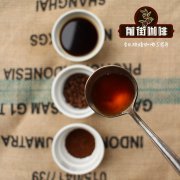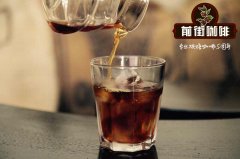Salvadoran Coffee Manor Las Ninfa Fairy Manor introduces _ how to bake Salvadoran coffee beans

Professional coffee knowledge exchange more coffee bean information please follow the coffee workshop (Wechat official account cafe_style)
Introduction to CJ1134 El Salvador Coffee Manor-Fairy Manor
Sun-treated Pacamara GrainPro bag packing
| 1 | introduction |
By Chris Kornman
Ricardo Valdivieso is the fourth generation of the family, and the family has always been known locally for growing and handling Pacamara varieties of coffee. The estate is called Las Ninfa (Nymph Manor or Fairy Manor), which is a sister estate of Santa Leticia Farm, both of which are very productive and scenic.
Founded in 1870, the estate was founded by the famous politician Francisco Menendez Valdevieso, a native and former general and president of El Salvador, as well as the founder of El Salvador's education system. For a hundred years, the manor has been inherited and managed by family members. Ricardo is the great-grandson of founder Francisco. In addition to coffee and protected forests, there are many Mayan ruins in the estate. Ricardo's daughter uses the relics to run a tourist eco-cabin at Santa Leticia and provide related activities.
The farm is located in the small town of Apaneca, near the coffee landmark in eastern El Salvador, Mount Santa Ana, also known as Ilamatepec. The mountains of El Salvador stretch from the north to the east, and the volcanoes are all active volcanoes. The climate and geography here are very suitable for growing coffee. Fertile volcanic soil, stable Pacific sea breezes, suitable elevations, distinct rainy and dry seasons make it a plant paradise.
2 | Analysis of raw beans
By Chris Kornman
Pacamara is a unique and widely studied coffee variety from El Salvador, which is the result of nearly 30 years of research and development by the Salvadoran Coffee Genome Research Institute (ISIC) since 1958. Although this variety accounts for only 0.22% of the total amount of coffee grown in El Salvador, its quality has been recognized by the majority of boutique coffee roasters.
Pacamara is a natural hybrid of Pacas and Marigogype (elephant beans), which are derived from bourbon and iron pickup. Pacas is derived from the bourbon species and was discovered by the Pacas family in the Santa Ana volcano region of El Salvador and is also named after its family name. The elephant bean is a variety of iron pickup, which was first found in the Bahia mountains of Brazil. The huge size of Pacamara coffee beans is derived from the genes of elephant beans.
This batch of coffee is in the shape of its name and is very large. 80% of the raw beans reach 18 mesh, and more than half of the beans cannot pass the first sieve. The shape of the bean is also consistent with the Pacamara, with a long bean body. The taste of raw beans is very rich, with a touch of fruit aroma, average color, and the density is not very high.
3 | Baking analysis
By Jen Apodaca
Usually when I get a sample coffee, I deliberately bake it in different ways. Recently, I will compare the two baking methods of low temperature + large firepower and high temperature + small firepower. However, sometimes although adjustments have been made in the baking operation, there is no change in the response on the curve. This is the case with this Pacamara. The reason may be that the baking quantity is too small, or because my 1 kg roaster is too small, I need to bake more or operate more variables in order to show on the curve. Another possibility is that Pacamara's bean body is too large and it has more room to absorb variables. Maybe you will have your own understanding. Although this operation has no effect on the curve, it does bring about a change in the taste of coffee. The baking batch with a short development time after explosion has a smooth and balanced taste, with a better sense of balance and syrup texture. Another batch with a slightly longer development time is more fruity and has the taste of red wine.
First batch: BlackBerry, dried strawberry, syrup, chocolate
Second furnace: Sangria sparkling wine, Concord grapes, blueberries, average balance
4 | Analysis using Behmor
By Evan Gilman
This Pacamara from El Salvador is relatively easy to bake. Although I bake more often with programs set up by Behmor, this time I still use manual methods. After an explosion, the development stage is very fast, the development time is 1:15, and the weightlessness of ripe beans is 13.3%. I suggest that we need to reduce the firepower after entering the first explosion. I lowered the firepower immediately after I heard the explosion. In this way, more sweetness can be developed without scorching. Try it slowly!
5 | Cooking analysis
By Chris Kornman
I found that this coffee has fast extraction speed and high solubility no matter using Kalita filter cup or making espresso. Using the gouache ratio of 15:1, the whole extraction time is only 3 minutes, including a pre-infiltration time of 60 seconds. The taste is fruity, grassy and sweet, clean and bright. The extraction rate is 20.5%. Under this extraction degree, the sweetness is good, but the viscosity is not high and the taste is not strong enough.
In the espresso test, I used too much coffee when I was grinding, and there were less than half a pound of beans when I was tested. The amount of powder is 17-17.5, the extraction time is 25 seconds, the coffee is 35 grams, the consistency is high, the taste of fruit juice is high, and when the coffee is 40 grams, the taste is brighter and has the taste of lemon. But both have the unique herbal aroma of Pacamara at the end.
Although this coffee doesn't give me an amazing feeling, it is unique as a SOE, with wonderful extraction changes and a lot of room for improvement.
END
Important Notice :
前街咖啡 FrontStreet Coffee has moved to new addredd:
FrontStreet Coffee Address: 315,Donghua East Road,GuangZhou
Tel:020 38364473
- Prev

What are the recipe ideas for hand-flushing matching? How do you spell hand-made beans? Hand-made mixed coffee
Professional coffee knowledge exchange more coffee bean information please follow the coffee workshop (Wechat official account cafe_style) what is the recipe for hand blending? How do you spell hand-made beans? What is the meaning of hand-made mixed coffee? Hand-made coffee represents the baking technology level of roasters. With the continuous updating of coffee concept, the development direction and mistakes of roasting technology.
- Next

The exquisite flavor and taste of Colombian Narinoa coffee? How to grade coffee beans with Lombara
Professional coffee knowledge exchange more coffee bean information please follow the coffee workshop (Wechat official account cafe_style) Colombia Narinoa exquisite coffee flavor and taste? How are Colombian coffee beans graded? How is Na Linglong's coffee growing environment? Narino province of Colombia is located in the southwest of the country, facing the Pacific Ocean to the west and Ecuador to the south.
Related
- Detailed explanation of Jadeite planting Land in Panamanian Jadeite Manor introduction to the grading system of Jadeite competitive bidding, Red bid, Green bid and Rose Summer
- Story of Coffee planting in Brenka region of Costa Rica Stonehenge Manor anaerobic heavy honey treatment of flavor mouth
- What's on the barrel of Blue Mountain Coffee beans?
- Can American coffee also pull flowers? How to use hot American style to pull out a good-looking pattern?
- Can you make a cold extract with coffee beans? What is the right proportion for cold-extracted coffee formula?
- Indonesian PWN Gold Mandrine Coffee Origin Features Flavor How to Chong? Mandolin coffee is American.
- A brief introduction to the flavor characteristics of Brazilian yellow bourbon coffee beans
- What is the effect of different water quality on the flavor of cold-extracted coffee? What kind of water is best for brewing coffee?
- Why do you think of Rose Summer whenever you mention Panamanian coffee?
- Introduction to the characteristics of authentic blue mountain coffee bean producing areas? What is the CIB Coffee Authority in Jamaica?

